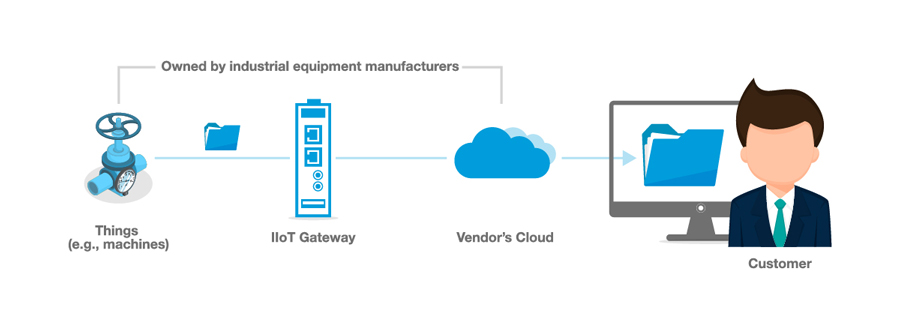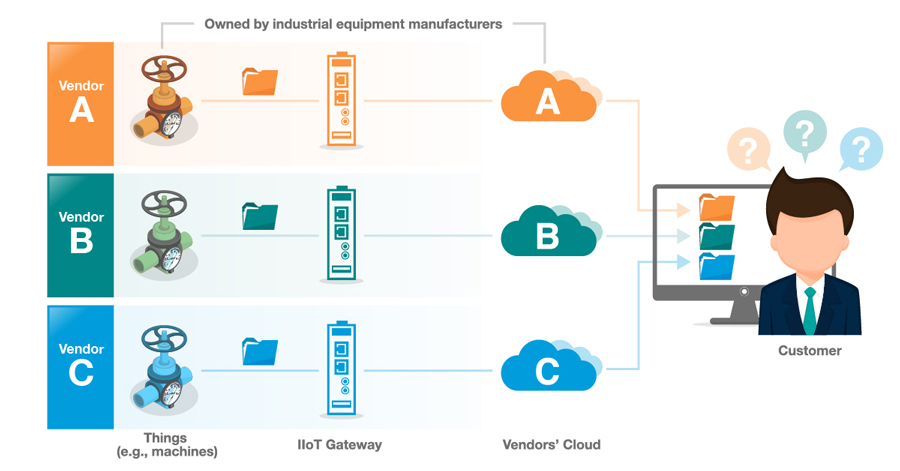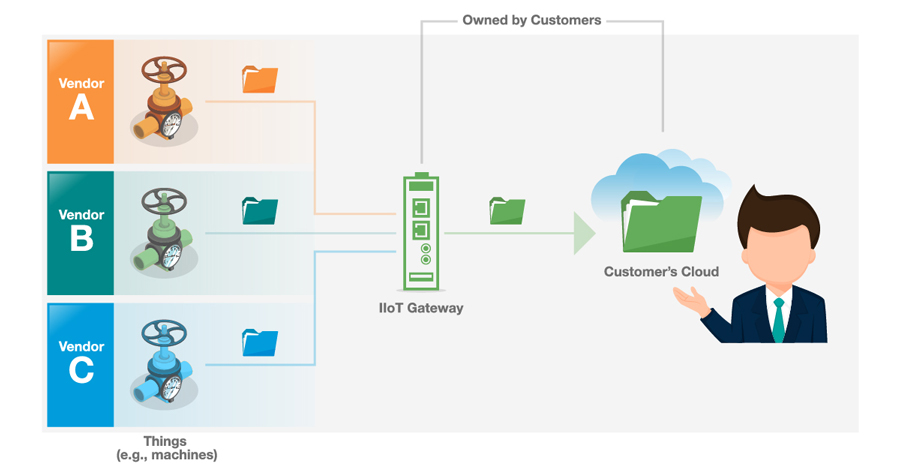The rise of the Industrial Internet of Things (IIoT) has radically altered how data is utilized in the Operational Technology (OT) sector. Previously, data was merely gathered for monitoring purposes to ensure smooth production operations. However, data now serves a purpose beyond mere information flow. By means of analysis, data can do more than just optimize products and services; it can also notably enhance operational efficiency, boost profits, and create fresh business models that were once inconceivable. The vast array of business opportunities made possible by data has positioned the IIoT as a pivotal technology for the future prosperity of virtually all enterprises.
The advantages brought about by this transformation have sparked a need for machinery that can cater to data acquisition and analysis efficiently, across all possible locations. Formerly, companies primarily valued production data for monitoring machine or asset productivity to ensure smooth operations. Presently, in addition to production data, machine condition data has become equally vital. Businesses rely heavily on predictive analysis of real-time operational data to forestall potential failures, thereby reducing maintenance costs and the risk of further damages. Moreover, industrial equipment manufacturers can employ machines’ historical data to offer customers more precise and speedy maintenance services, thereby cutting down on personnel expenses. Lastly, this data can be used to optimize a machine’s operations based on dynamic changes in environmental and business objectives, as opposed to the traditional “set-and-forget” approach.
Despite the myriad benefits of big data, progress of the IIoT in the industrial sphere remains sluggish. Various factors impede this progress, including the diversity of edge protocols, nonstandardized data, cloud connectivity, cybersecurity, and the management of large-scale systems, among others.
The Two Most Prevalent IIoT Connectivity Solutions
In the initial phases of the IIoT (as recent as two to three years ago), industrial equipment manufacturers’ response to this intricate and demanding issue was to furnish a comprehensive IIoT solution. Customers simply needed to pay for this service or functionality, and the equipment providers would handle the rest. Over time, customers found themselves juggling numerous IIoT solutions from diverse vendors on disparate platforms, lacking interoperability. Moreover, they failed to grasp the overarching purpose behind the data they had gathered. Information was scattered in silos across various vendors.
As customers grappled with this challenge, market demand drove the need for open architectures that allowed customers to shape and maintain their IIoT strategy, enabling communication with any device from any location. Nevertheless, adequately implementing such a solution on a large scale presents complex challenges in terms of investment and capability. Even well-intentioned and well-funded customers encounter significant hurdles in developing such a system.
Let’s delve deeper into the two common connectivity approaches: proprietary IIoT connectivity solutions, offering a convenient and managed solution but limiting flexibility, openness, and data ownership, and open IIoT connectivity solutions , focusing on integrating various systems seamlessly and granting customers ownership of the solution.
Proprietary IIoT Connectivity Solutions: Uncomplicated, Effortless Solutions
A plethora of industrial equipment manufacturers recognized the value of data analytics and initiated the provision of their proprietary IIoT connectivity solutions to customers. To harness the data wealth, IIoT gateways are either placed in front of or embedded within the “thing”, transmitting data on the “thing’s” status from the machine to the vendor’s cloud. This user-friendly turnkey solution empowers customers to swiftly capture, manage, visualize, and analyze data from these devices on a cloud-based platform. Users find this system intuitive, as they only need to log into the vendor’s cloud to access their data. Furthermore, it alleviates customer workload by placing the responsibility of system development and deployment solely on the industrial equipment manufacturer, thereby reducing overall IT costs for customers.

(Fig.1. A proprietary IIoT connectivity solution)
Some industrial equipment manufacturers also ventured into providing data analysis services on top of data collection to aid customers in comprehending their machines’ behavior better. Customers with specific application requirements, such as monitoring remote equipment operations, favor this offering. In the oil and gas sector, maintaining punctual operation of remote devices (pumps, control valves, compressors, etc.) is crucial. This necessity prompted industrial equipment manufacturers like Baker Hughes, Emerson, Schlumberger, etc., to deploy artificial intelligence (AI) for real-time analysis of data such as pump pressure, flow, temperature, etc. By juxtaposing this data with historical benchmarks, they promptly adjust equipment parameters to ensure their normal operation with minimal human intervention. Consequently, the hassle-free deployment and user-friendly features of proprietary IIoT connectivity solutions have greatly appealed to customers.
Ease of Use, But at What Expense?
The uniform nature of this easy-to-implement solution limits its service to the industrial equipment manufacturer’s own devices. However, in real-world scenarios, a mid-sized enterprise typically possesses equipment and assets from multiple suppliers, spanning various locations and applications. This heterogeneous and complex setting usually demands the enterprise to use a distinct solution for each system offered by diverse industrial equipment manufacturers. This could lead to additional financial outlays and complications resulting from isolated information systems that lack interoperability.
- Restricted Integration: Closed IIoT solutions transmit data to various platforms, each utilizing distinct protocols and formats. This creates a substantial backend effort to merge the data.
- Lack of Data Ownership: Storing customer machine data on a private platform developed by the equipment manufacturer raises data ownership concerns. If the data is stored in a platform owned by the manufacturer, does it still belong to the customer? Moreover, shifting platforms in the future may pose challenges in data transportation or lead to data loss. This jeopardizes the customer’s historical data and experiences, potentially resulting in data leaks.

(Fig.2. Connecting multiple things in a proprietary IIoT connectivity solution)
Is Embracing Openness Key to Connecting Diverse “Things”?
As data assumes a critical role in a business’s core success, ownership of data, availability across all “things” (not just select ones), and integration flexibility become paramount considerations whendeciding on resolutions.
Within open IIoT connectivity frameworks, manufacturers of industrial equipment expose APIs or employ open or standard-based protocols to enable customers to retrieve the data independently. On the other hand, at times customers construct their own resolutions by linking separate front-end devices from various manufacturers to a highly integrated IIoT hub. The varied data formats from the diverse manufacturers are consolidated by the IIoT hub, thereby significantly easing the integration challenges when transmitting data to the cloud later on. Additionally, the process no longer necessitates the data to pass through a third-party’s platform, enhancing its security.
Let’s consider the oil and gas sector as an illustration. Oil production and real-time oil prices are closely correlated, implying that transparency in the production line can either make or break the profit margin. To obtain real-time data from exploration, development, and production up to final transportation, oil companies collaborated to establish an open platform. This called for the manufacturers of industrial equipment in the supply chain to collaborate by sharing their equipment, production, or environmental data to efficiently produce an oil field.

(Fig.3. An open IIoT connectivity solution)
The query now swiftly transforms to “What can I purchase?” versus “What do I need to construct myself?” The commercially accessible resolutions these days for open architectures have expanded briskly over the past year. Diverse software modules are now available to achieve this:
- Cloud Edge Software like AWS IoT Greengrass/Azure IoT Edge to extend cloud infrastructure to the edge
- SCADA Edge Software such as Ignition Edge/AVEVA Edge IoT View to interact with a wide array of industrial edge protocols
- Infrastructure service offerings to extend security, networking, and management to the edge like ZEDEDA, OpenVPN, and TOSIBOX Lock for Container
- ML/AI edge solutions for edge processing before transmitting back to the cloud
Above all, make sure to opt for a robust yet dependable IIoT hub at the core, which not only can execute the aforementioned software modules but also has the capability to link to the cloud (e.g., LTE, Wi-Fi, existing WAN) and edge (e.g., I/O, Ethernet, USB, Serial, other).
Summary: Proprietary or Open?
For enterprises desiring to deploy a swift IIoT resolution for a singular vendor’s, “thing” to fetch data and gain the advantages of the IIoT, an easy-to-implement, proprietary IIoT connectivity resolution is the more gratifying selection. For businesses necessitating IIoT data on a broader scale, interfacing numerous distinct “things”, and seeking a more customized fit with complete data ownership, an open IIoT connectivity resolution would be capable of delivering the required optimization.
As the IIoT market and IIoT ecosystem progress, more ready-to-use software and cloud offerings, without a doubt, will continue to provide customers simpler and highly scalable products to develop their own open IIoT resolutions. Proprietary IIoT resolutions are also swiftly adapting to offer more open API’s and cloud-to-cloud integration, as well as making their resolution more accessible for customers to reach their data more effortlessly.
For more information on IIoT hubs for your proprietary or open resolutions, click here.
- Not Only for Automobiles: Discovering CANbus Technology in Various Industrial Settings - October 29, 2024
- Boost Your Network Performance: An Exciting Manual to PoE Switches! - September 10, 2024
- Understanding Gigabit Switches: Industrial vs Regular Gigabit - September 4, 2024


